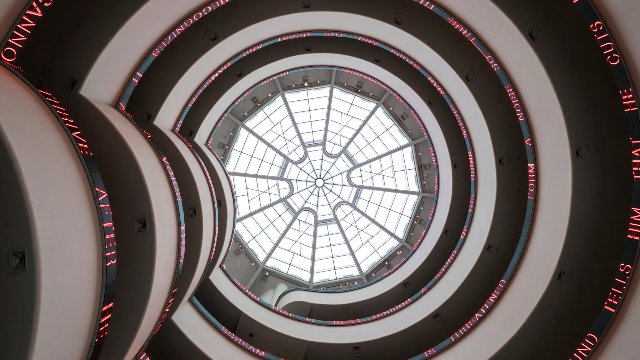Jenny Holzer at the Guggenheim
Jenny Holzer: Light Line,
By: Guggenheim - May 17, 2024
Jenny Holzer: Light Line
Solomon R. Guggenheim Museum
1071 Fifth Avenue, New York
May 17–September 29, 2024
(NEW YORK, NY—May 17, 2023) Almost thirty-five years ago, Jenny Holzer (b. 1950, Gallipolis, Ohio) created a spiraling LED display for her Guggenheim Museum exhibition. The LED sign—blinking while changing colors, fonts, and special effects—was the longest in the world at the time and is considered a masterpiece of text-based art.
Open through September 29, 2024, the Guggenheim presents the solo exhibition Jenny Holzer: Light Line, featuring a reimagining of Holzer’s 1989 landmark artwork. Holzer has treated the entire museum as an installation, placing pieces in unexpected spaces, such as outdoor planters and a restroom, to echo chance encounters with her work on city streets. Holzer’s voice is vital and incisive, and her work, whether on posters, electronic signs, stone benches, or paintings, explores some of the most pressing issues of our time, from climate justice to women’s rights, from corruption to war.
The new manifestation of Holzer’s electronic sign, Installation for the Solomon R. Guggenheim Museum (1989/2024), transforms the building with an updated and expanded display of scrolling texts, featuring language from her iconic series, such as Truisms and Inflammatory Essays. Taking up three revolutions of the Frank Lloyd Wright–designed rotunda in the 1989 exhibition, the new installation climbs all six ramps up to the building’s oculus, realizing the artist’s original vision.
Developed in close collaboration with the artist and her studio, the new sign was the subject of an ambitious research project. Guggenheim conservators reverse-engineered the 1989 LED hardware and computer program, which helped inform the new manifestation. This investigation documents future variability and technology upgrades, and contributes to scholarship and methodologies for the preservation of technology-based artworks.
Light Line also features a selection of Holzer’s works from the 1970s to the present day, including paintings, works on paper, plaques, and stone pieces. Lee Quiñones, one of the originators of street art and a longtime collaborator of Holzer’s, has graffitied the walls of the museum’s High Gallery over the artist’s colorful Inflammatory Essays posters.
Marking the opening of the exhibition, Holzer’s For the Guggenheim will be displayed on the building’s facade every evening at sundown through May 20. The light projection—first commissioned by the museum in 2008—will illuminate the architecture with poems and eyewitness accounts that speak to the necessity of peace.
An artist’s book, titled TRACE, has been published on the occasion of the exhibition. Each page features a phrase chosen by Holzer from three of her text series—Truisms, Living, and Survival—in the form of preparatory drawings she has used for many years to create her iconic stone benches. In addition, visitors can engage with the exhibition through dedicated accessibility programs and content in the Guggenheim’s comprehensive digital guide.
This solo exhibition reflects how Holzer’s use of the written word throughout her career has long captivated audiences around the world. The messaging is timely and offers audiences the opportunity to encounter the extraordinary, the political, the mundane, and the provocative through the artist’s pioneering approach to technology and language.
Jenny Holzer: Light Line is organized by Lauren Hinkson, Associate Curator for Collections with Jenny Holzer.
Conservation research and treatment of Jenny Holzer’s Installation for the Solomon R. Guggenheim Museum (1989/2024) is led by Lena Stringari, Deputy Director and Andrew W. Mellon Chief Conservator, and Agathe Jarczyk, Associate Time-Based Media Conservator.
The Leadership Committee for Jenny Holzer: Light Line is gratefully acknowledged for its generosity, with special thanks to Edlis-Neeson Foundation, the Anna-Maria and Stephen Kellen Foundation, Barbara and Andrew Gundlach, Hauser & Wirth, Sprüth Magers, Kukje Art & Culture Foundation, Dakis Joannou, Andy and Christine Hall, The Peter Norton Family Foundation, Agnes Gund, and those who wish to remain anonymous. Additional funding is provided by the Solomon R. Guggenheim Museum’s Collections Council and the International Director’s Council. Conservation funding was provided by Suzanne Deal Booth.
Support is also generously provided by The National Endowment for the Arts.
Funding for the conservation of Jenny Holzer: Light Line was generously provided through a grant from the Bank of America Art Conservation Project.
For more than forty years, Jenny Holzer has presented her astringent ideas, arguments, joys, and sorrows in public places and international exhibitions, including Times Square, the Venice Biennale, the Guggenheim museums in New York and Bilbao, and the Louvre Abu Dhabi. Her medium—whether a T-shirt, plaque, electronic sign, or stone bench—is writing, and the public dimension is integral to her work. Starting in the 1970s with her New York City street posters and continuing through her recent light projections on landscapes and architecture, her practice has rivaled ignorance and violence with humor, kindness, and courage. Holzer received the Leone d’Oro at the Venice Biennale in 1990, the World Economic Forum’s Crystal Award in 1996, and the US State Department’s International Medal of Arts in 2017. She lives and works in New York.

